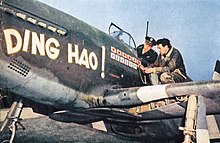356th Fighter Squadron
This article needs additional citations for verification. (December 2012) |
| 356th Fighter Squadron
F-35 Lightning II of the 356th Fighter Squadron at Eielson Air Force Base | |
|---|---|
| Active | 1942–1946; 1956–1992; 2019–present |
| Country | United States |
| Branch | United States Air Force |
| Role | Fighter |
| Part of | 354th Operations Group |
| Garrison/HQ | Eielson Air Force Base |
| Nickname(s) | Green Demons |
| Motto(s) | Give'm Hell! |
| Colors | Black, Green, Red |
| Engagements | |
| Commanders | |
| Current commander | Lt Col Ryan Worrell |
| Notable commanders | Lt Col James Christensen |
| Insignia | |
| 356th Fighter Squadron emblem |  |
| World War II squadron emblem |  |




The 356th Fighter Squadron is an active United States Air Force fighter squadron. It is assigned to the 354th Fighter Wing, being stationed at Eielson Air Force Base, Alaska. It was reactivated in 2019 to operate the Lockheed Martin F-35 Lightning II.
The squadron was first activated during World War II and flew the North American P-51 Mustang on escort missions for Eighth Air Force bombers over western Europe from mid-1943. With IX Fighter Command, it was re-equipped with the Republic P-47 Thunderbolt in early 1944 and flew ground attack missions until the end of the war.
It was reactivated in 1956 and became the 356th Tactical Fighter Squadron, flying the
World War II
Activated on 15 November 1942 at
In late 1943, the strategic bombardment campaign over
Was relieved from escort duty and was re-equipped with
Moved to
Remained in Occupied Germany as part of the
Cold War
Reactivated by
Korean duty
During the
From Misawa, aircraft and personnel of the 356th rotated six F-100D aircraft every ten days to Kunsan and Taegu performing Nuclear alert duty. The 356th was on a TDY status to Misawa AB until 13 August 1965 when it was permanently reassigned to the 39th AD.
In August 1967, the
On 15 January 1968, the 475th Tactical Fighter Wing was activated at Misawa and took over as host unit from the 39th Air Division.
On 23 January 1968, as a response to the capture by the
When the 354 TFW became the permanent host unit at Kunsan AB in July 1968, the 356th was NOT assigned to its 354th TFW host unit at Myrtle Beach AFB. At Kunsan, the 356 TFS was part of Detachment 1, 475th Tactical Fighter Wing, which was a separate operating unit. On 15 March 1971, the 3d Tactical Fighter Wing replaced the 475 TFW at Misawa and absorbed its assets. The 356 TFS was inactivated and the squadron was reassigned back to the 354 TFW at Myrtle Beach AFB.
Post-Vietnam era
Returning to Myrtle Beach AFB in 1971, the unit was re-equipped with A-7D Corsair II fighter-bombers. From 1971 to 1977 the squadron remained at Myrtle Beach AFB and became a LIFT Training Squadron, not being on operational deployment status, supporting the 353d and 355th Tactical Fighter Squadrons which were deployed to Thailand for combat operations, 1972–1974, and to NATO bases in Germany (1975–1976). Frequently interchanged personnel with the provisional 4554th Tactical Fighter Training Squadron assigned to the 354th at Myrtle Beach.
The 356th Tactical Fighter Squadron was re-equipped with the Republic
Returned to the United States in March 1991, and returned to peacetime training operations. Immediately began phasing down with the designated BRAC 1990 closure of Myrtle Beach AFB and the pending inactivation of its host Wing. The squadron's aircraft were dispersed, being reassigned to Air National Guard and other active Air Force Fighter Squadrons throughout the balance of 1991 and early 1992. The squadron was inactivated 10 June 1992.
The squadron was reactivated on 10 October 2019 at
Lineage
- Constituted 356th Fighter Squadron 12 November 1942.
- Activated 15 November 1942.
- Inactivated 31 March 1946.
- Redesignated 356th Fighter-Day Squadron 28 September 1956.
- Activated 19 November 1956.
- Redesignated 356th Tactical Fighter Squadron 1 July 1958.
- Redesignated 356th Fighter Squadron 1 November 1991
- Inactivated 10 June 1992
- Activated 10 October 2019
Assignments
- 354th Fighter Group, 12 November 1942 – 31 March 1946
- 354th Fighter-Day Group, 19 November 1956
- 354th Fighter-Day (later, Tactical Fighter) Wing, 25 September 1957
- 39th Air Division, 29 November 1965
- 475th Tactical Fighter Wing, 15 January 1968
- Attached to: Detachment 1 or Detachment 2, 475th Tactical Fighter Wing, 15 January 1968 – 15 March 1971
- Attachments were for 10-day periods, rotating every 30 days
- 3d Tactical Fighter Wing, 15 March 1971
- 354th Tactical Fighter (later, Fighter) Wing, 15 May 1971 – 10 June 1992
- 354th Operations Group, 10 October 2019 -
Stations
|
|
Survivor
Aircraft number 56-3417, F-100D-86-NA (formerly F-100D-85-NH), with
References
![]() This article incorporates public domain material from the Air Force Historical Research Agency
This article incorporates public domain material from the Air Force Historical Research Agency
- ^ USAFHRA Document 00470754
- ^ USAFHRA Document 01027768
- ^ Guerrisky, Aaron Larue (10 October 2019). "Eielson AFB reactivates 356th Fighter Squadron". 354th Fighter Wing Public Affairs. Retrieved 18 October 2019.
- ^ All of 417's documentation is in the Collections and Restorations Offices, Wings Over the Rockies Air and Space Museum, Denver, CO.
- ^ Wings Over the Rockies Museum, Official site
